Dual-Frequency Programmed Harmonics Modulation-based Simultaneous Wireless Information and Power Transfer System via a Common Resonance Link
Abstract
1. Introduction
2. System Structure and Principle
2.1. System Structure
2.2. System Operation Principle
2.2.1. DFPHM Switching Angles
2.2.2. Dual-Mode Operation
3. System Parameter Design
3.1. Wave Trappers Design
3.2. Analysis of Impedance
4. Experiment Verification
5. Conclusions and Future Work
Author Contributions
Funding
Conflicts of Interest
References
- Krikidis, I.; Timotheou, S.; Nikolaou, S.; Zheng, G.; Ng, D.W.K.; Schober, R. Simultaneous wireless information and power transfer in modern communication systems. IEEE Commun. Mag. 2014, 52, 104–110. [Google Scholar] [CrossRef]
- Zhou, X.; Zhang, R.; Ho, C.K. Wireless Information and Power Transfer: Architecture Design and Rate-Energy Tradeoff. IEEE Trans. Commun. 2013, 61, 4754–4767. [Google Scholar] [CrossRef]
- Chau, K.T. Electric Vehicle Machines and Drives – Design, Analysis and Application; John Wiley & Sons: Hoboken, NJ, USA, 2015. [Google Scholar]
- Zhang, H.; Gao, S.; Ngo, T.; Wu, W.; Guo, Y. Wireless Power Transfer Antenna Alignment Using Intermodulation for Two-Tone Powered Implantable Medical Devices. IEEE Trans. Microw. Theory Tech. 2019, 67, 1708–1716. [Google Scholar] [CrossRef]
- Nie, Z.; Yang, Y. A Model Independent Scheme of Adaptive Focusing for Wireless Powering to In-Body Shifting Medical Device. IEEE Trans. Antennas Propag. 2018, 66, 1497–1506. [Google Scholar] [CrossRef]
- Zhang, K.; Zhu, Z.; Song, B.; Xu, D. A Power Distribution Model of Magnetic Resonance WPT System in Seawater. In Proceedings of the IEEE 2nd Annual Southern Power Electronics Conference SPEC, Auckland, New Zealand, 5–8 December 2016; pp. 1–4. [Google Scholar]
- Hasaba, R.; Okamoto, K.; Kawata, S.; Eguchi, K.; Koyanagi, Y. Experimental Study on Over 10 Meters Magnetic Resonance Wireless Power Transfer under Sea with Coils. In Proceedings of the 2018 IEEE Wireless Power Transfer Conference (WPTC), Montreal, BC, Canada, 3–7 June 2018; pp. 1–4. [Google Scholar]
- Si, Y.; Lao, J.; Zhang, X.; Liu, Y.; Cai, S.; González-Vila, Á.; Li, K.; Huang, Y.; Yuan, Y.; Caucheteur, C.; et al. Electrochemical Plasmonic Fiber-optic Sensors for Ultra-Sensitive Heavy Metal Detection. J. Lightwave Technol. 2019, 37, 3495–3502. [Google Scholar] [CrossRef]
- Injeti, S.K.; Thunuguntla, V.K. Optimal integration of DGs into radial distribution network in the presence of plug-in electric vehicles to minimize daily active power losses and to improve the voltage profile of the system using bioinspired optimization algorithms. Prot. Control Mod. Power Syst. 2020, 5, 21–35. [Google Scholar] [CrossRef]
- Ponnimbaduge Perera, T.D.; Jayakody, D.N.K.; Sharma, S.K.; Chatzinotas, S.; Li, J. Simultaneous Wireless Information and Power Transfer (SWIPT): Recent Advances and Future Challenges. IEEE Commun. Surv. Tutor. 2018, 20, 264–302. [Google Scholar] [CrossRef]
- Wang, T.; Liu, X.; Jin, N.; Tang, H.; Yang, X.; Ali, M. Wireless Power Transfer for Battery Powering System. Electronics 2018, 7, 178. [Google Scholar] [CrossRef]
- Simard, G.; Sawan, M.; Massicotte, D. High-speed OQPSK and efficient power transfer through inductive link for biomedical implants. IEEE Trans. Biomed. Circuits Syst. 2010, 4, 192–200. [Google Scholar] [CrossRef] [PubMed]
- Kim, J.; Wei, G.; Kim, M.; Ryo, H.; Zhu, C. A Wireless Power and Information Simultaneous Transfer Technology Based on 2FSK Modulation Using the Dual Bands of Series–Parallel Combined Resonant Circuit. IEEE Trans. Power Electron. 2019, 34, 2956–2965. [Google Scholar] [CrossRef]
- Wu, J.; Zhao, C.Y.; Jin, N.; He, S.B.; Ma, D.G. Bidirectional Information Transmission in SWIPT System with Single Controlled Chopper Receiver. Electronics 2019, 8, 1027. [Google Scholar] [CrossRef]
- Wu, J.; Zhao, C.W.; Lin, Z.; Du, J.; Hu, Y.; He, X. Wireless Power and Data Transfer via a Common Inductive Link Using Frequency Division Multiplexing. IEEE Trans. Ind. Electron. 2015, 62, 7810–7820. [Google Scholar] [CrossRef]
- Sun, Y.; Yan, P.X.; Wang, Z.H. The parallel transmission of power and data with the shared channel for an inductive power transfer system. IEEE Trans. Power Electron. 2016, 31, 5495–5502. [Google Scholar] [CrossRef]
- Pantic, Z.; Lee, K.; Lukic, S.M. Multi-frequency inductive power transfer. IEEE Trans. Power Electron. 2014, 29, 5995–6005. [Google Scholar] [CrossRef]
- Liu, W.; Chau, K.T.; Lee, C.H.T.; Jiang, C.; Han, W.; Lam, W.H. Multi-Frequency Multi-Power One-to-Many Wireless Power Transfer System. IEEE Trans. Magn. 2019, 55, 1–9. [Google Scholar] [CrossRef]
- Wu, J.; Li, Y.G.; Jin, N.; Deng, W.; Tang, H.J.; Vaclav, S. A GaN-based Wireless Power and Information Transmission Method Using Dual-Frequency Programmed Harmonic Modulation. IEEE Acess 2019, 8, 49848. [Google Scholar] [CrossRef]
- Wu, J.; Bie, L.Z.; Jin, N.; Guo, L.L.; Zhang, J.T.; Tao, J.G.; Vaclav, S. Dual-Frequency Output of Wireless Power Transfer System with Single Inverter Using Improved Differential Evolution Algorithm. Energies 2020, 13, 2209. [Google Scholar] [CrossRef]
- Sanchez, A.D.R.; Hurtado, J.C.C. Spectral Analysis of OOK modulation with rectangular carrier and it conversion in a signal modulated in OOK with sine carrier. Application in RFID systems. IEEE Lat. Am. Trans. 2016, 14, 2152–2156. [Google Scholar] [CrossRef]
- Jeong, D.; Lee, H.; Chung, T.; Lee, S.; Lee, J.; Kim, B. Optimized Ultralow-Power Amplifier for OOK Transmitter With Shaped Voltage Drive. IEEE Trans. Microw. Theory Tech. 2016, 64, 2615. [Google Scholar] [CrossRef]
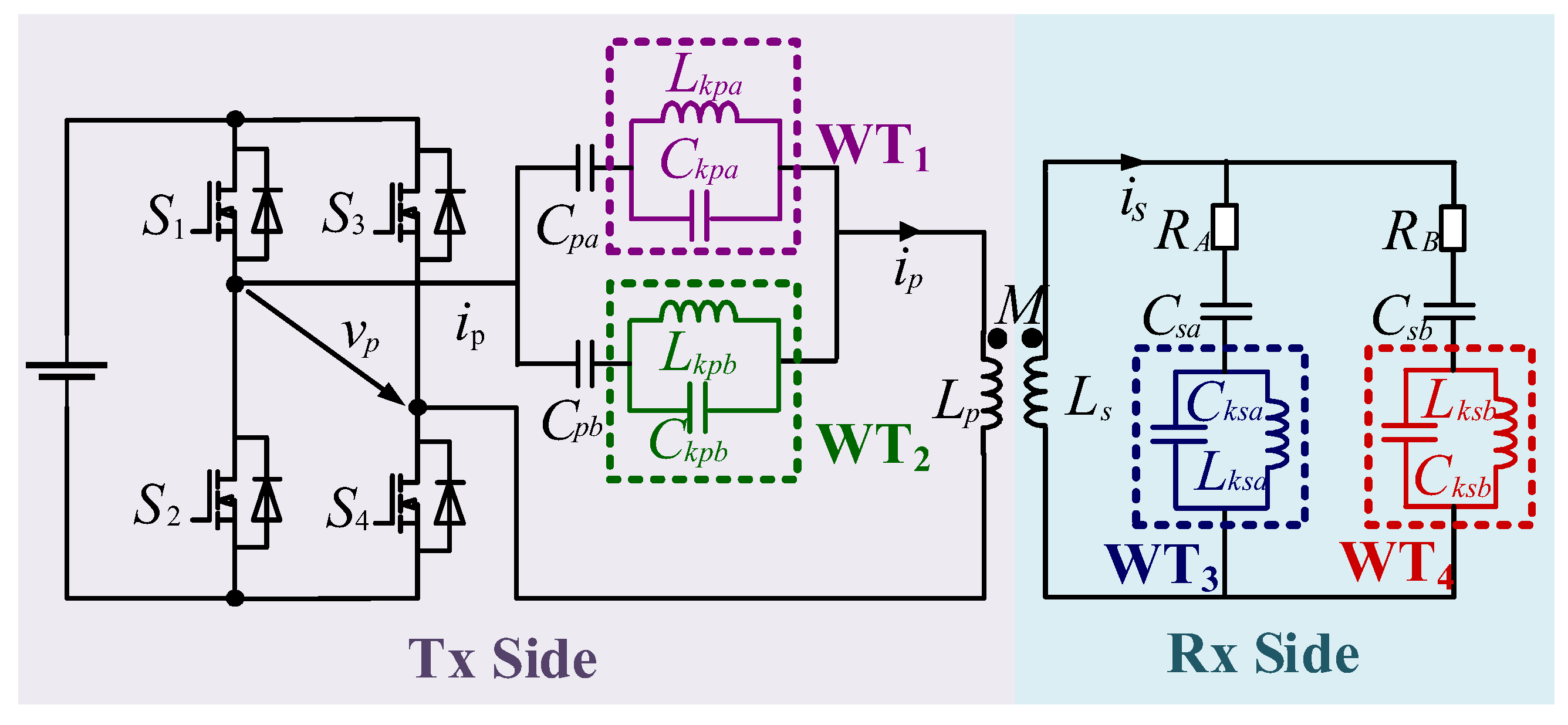

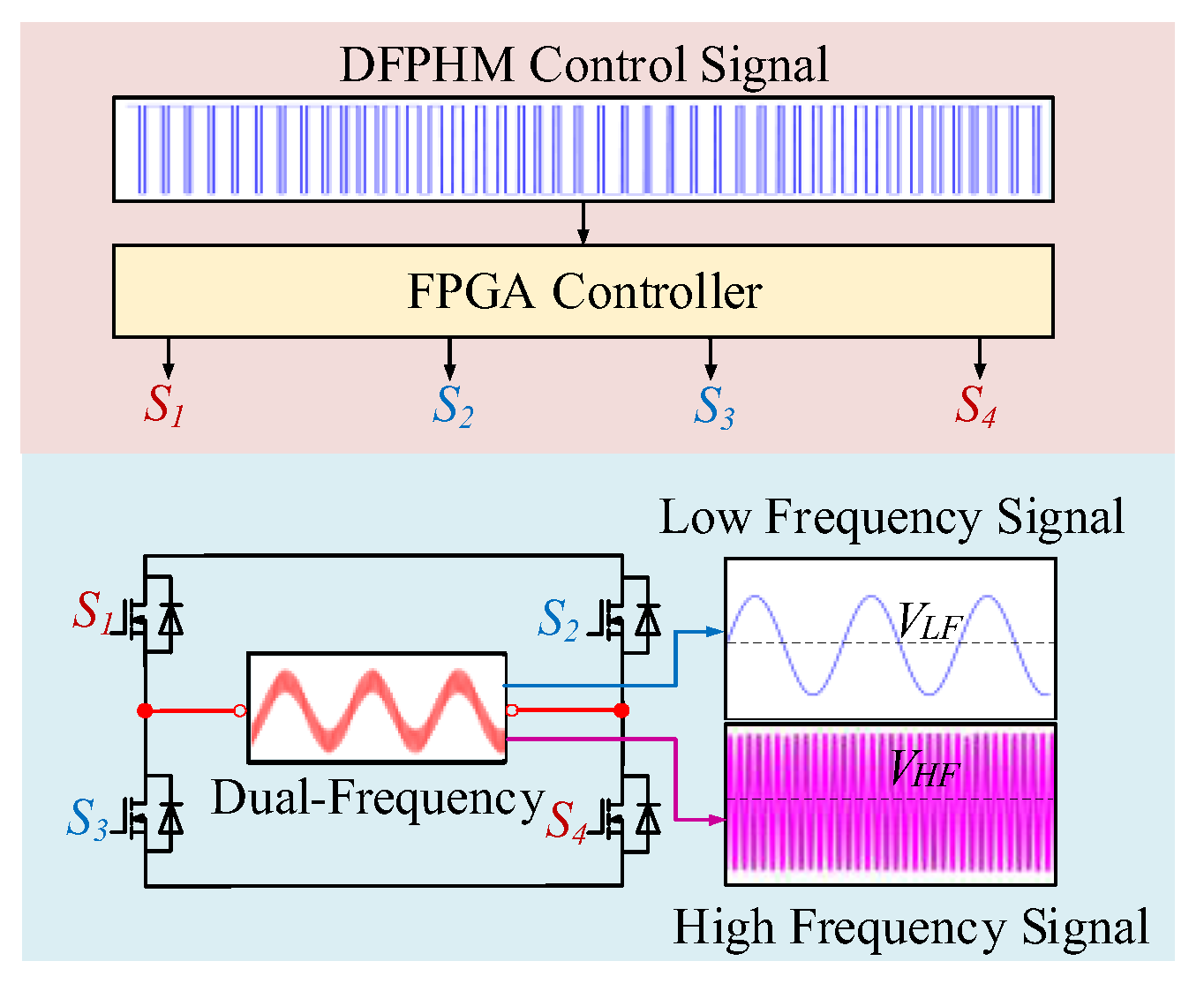
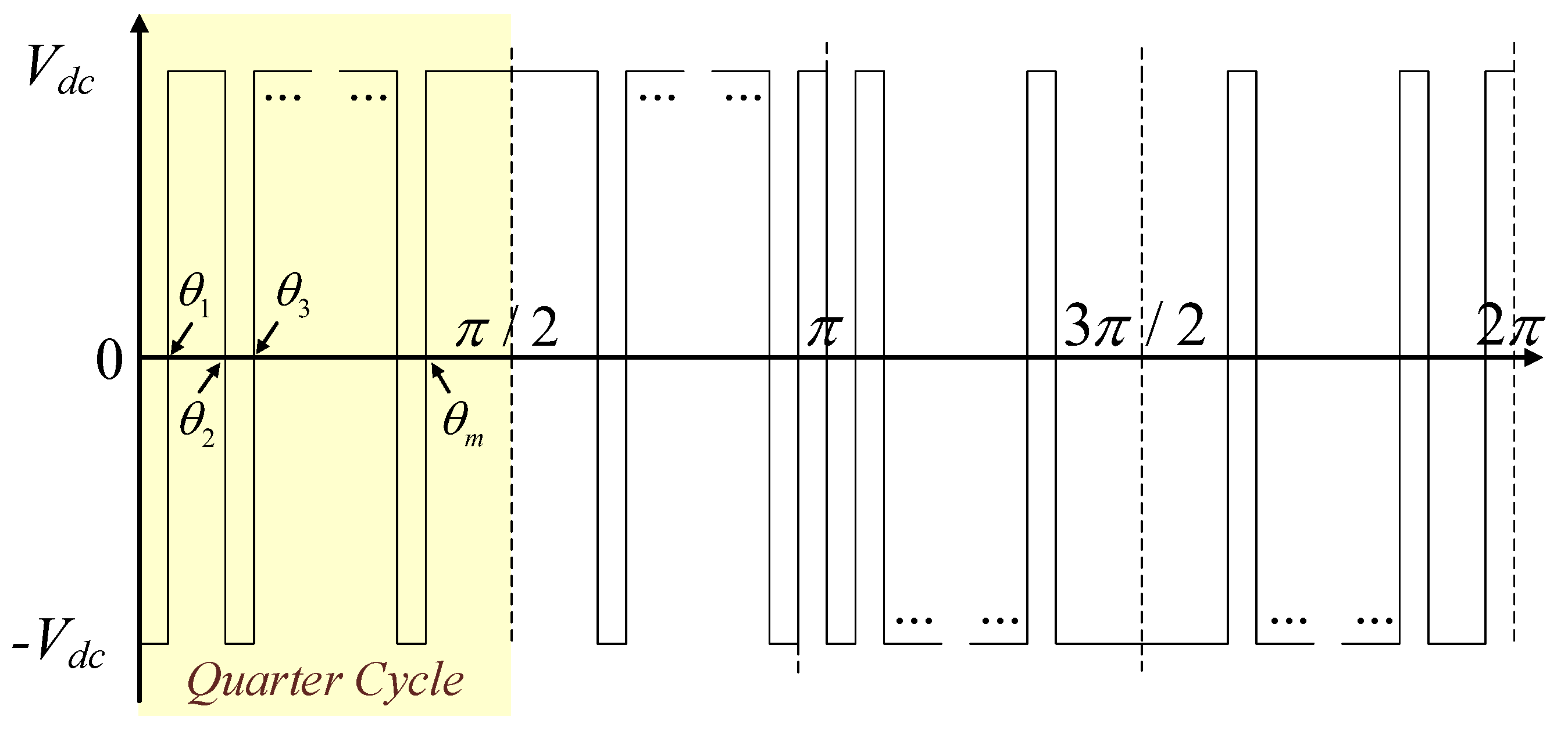
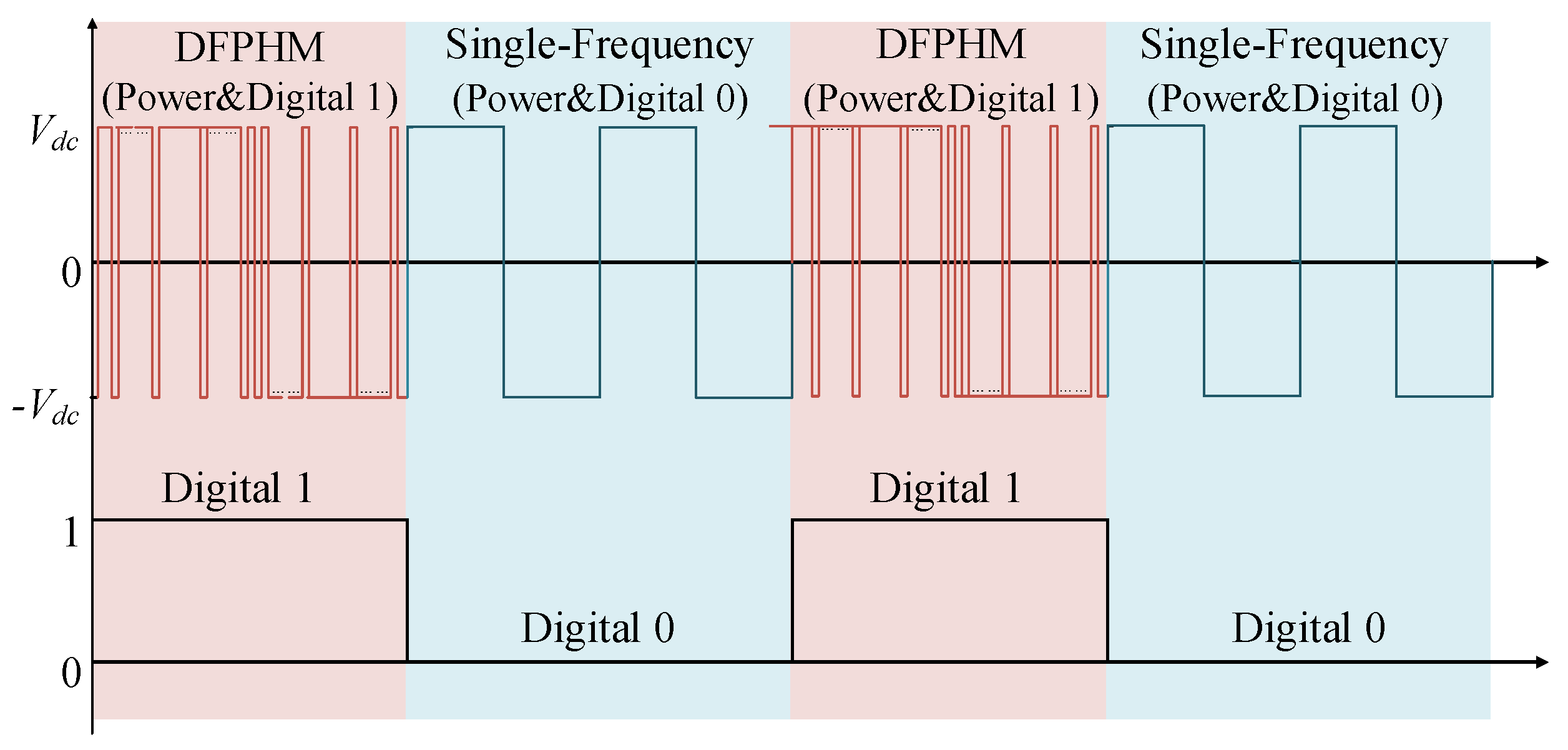

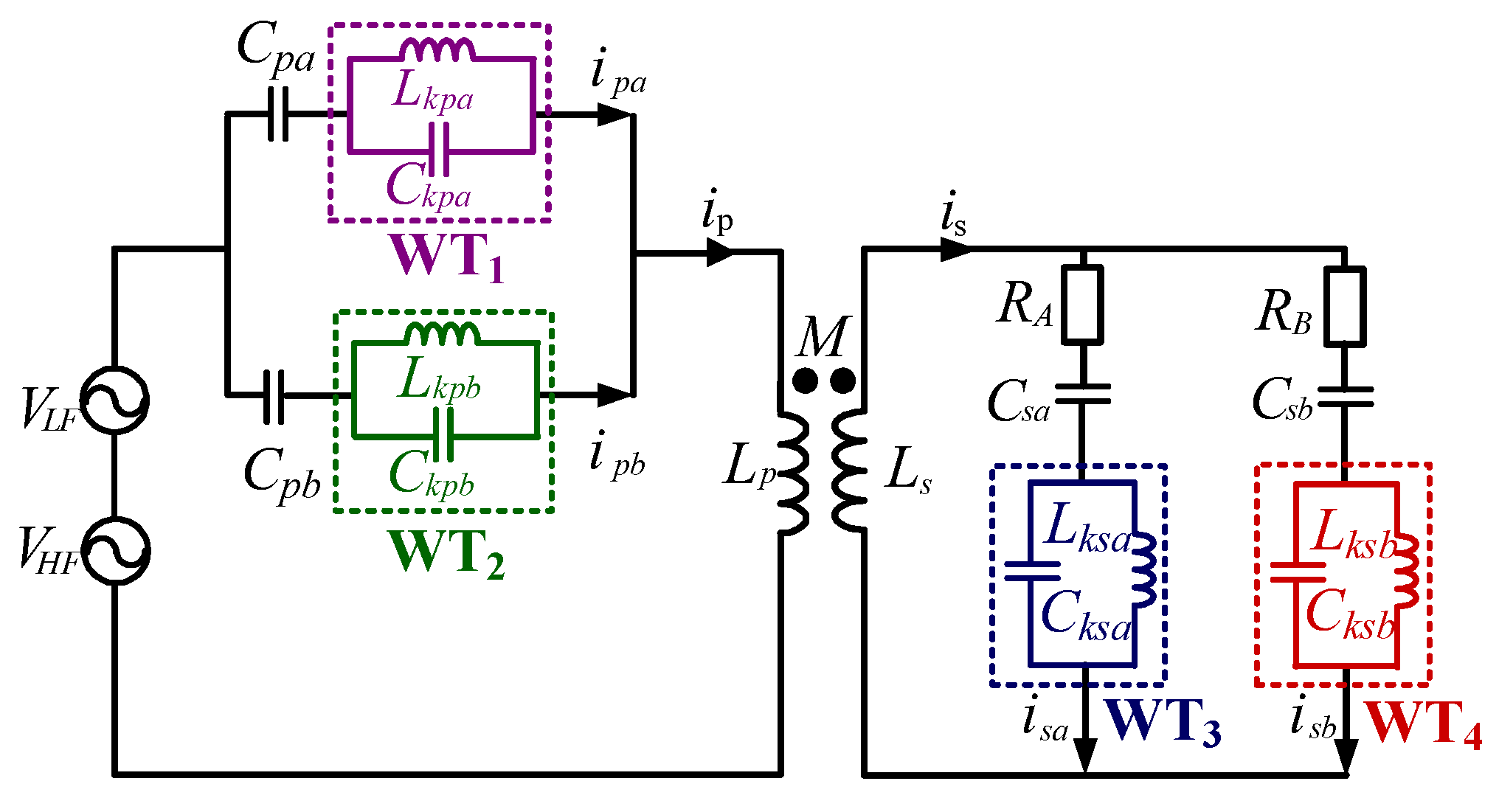

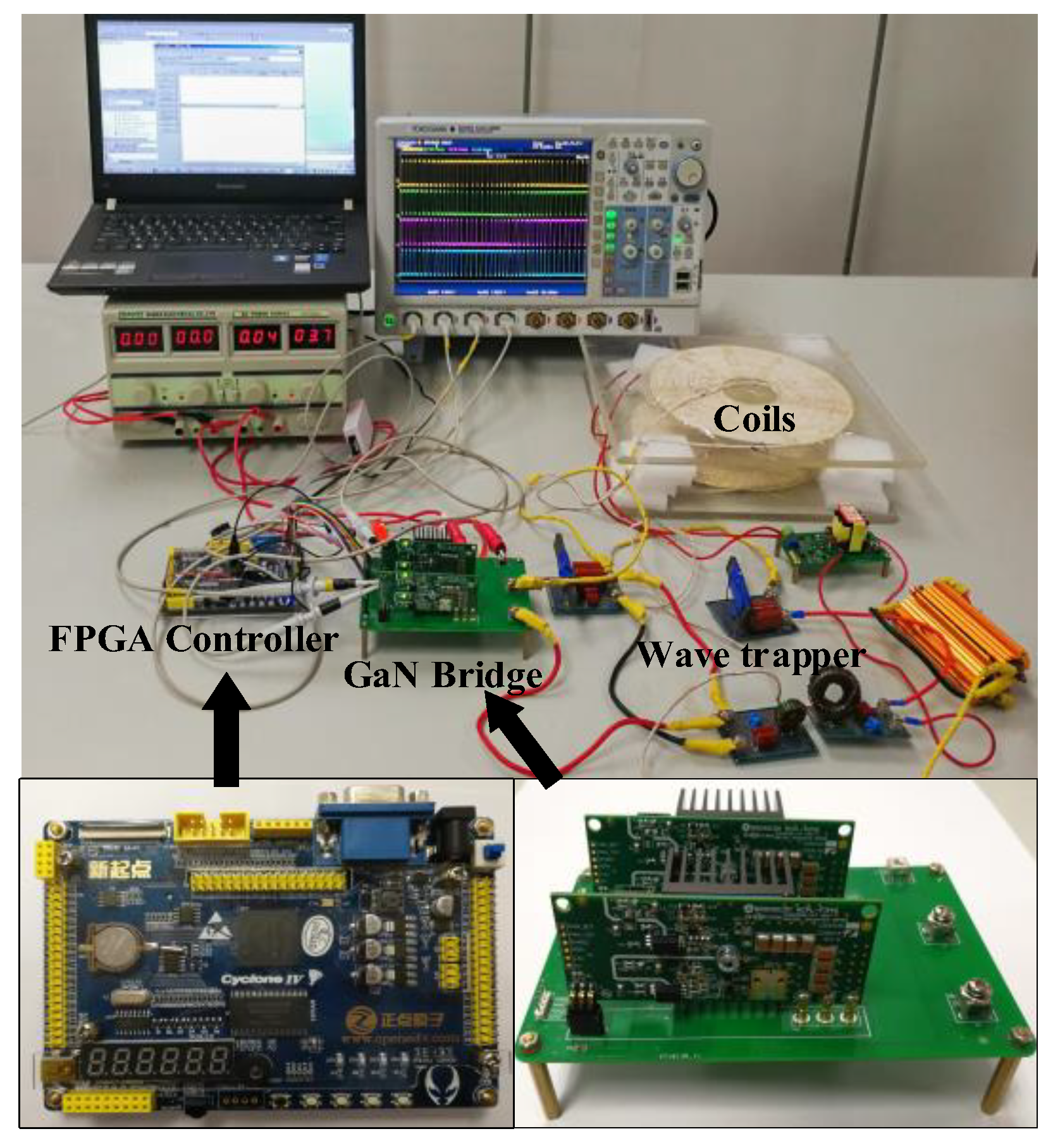
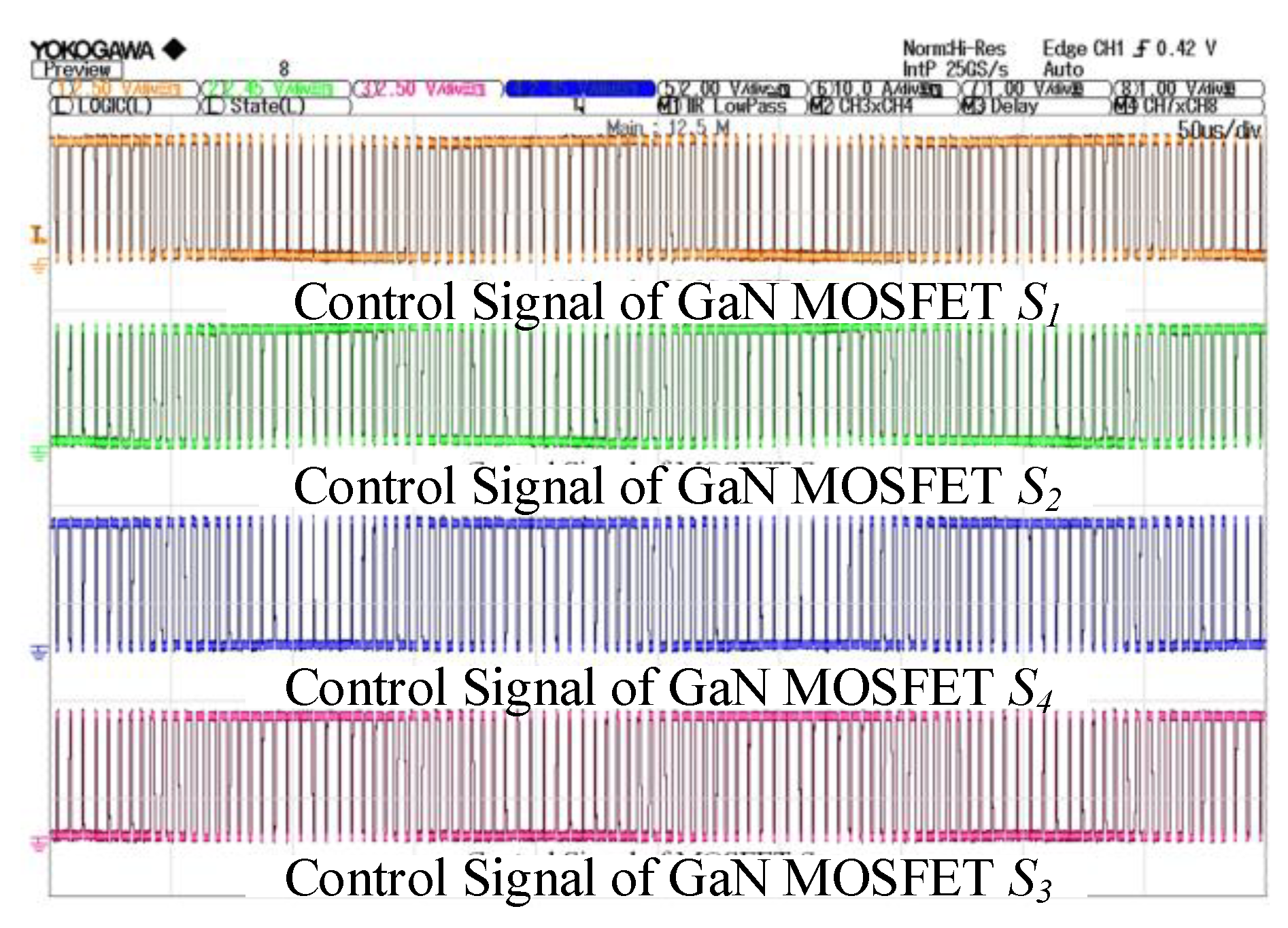
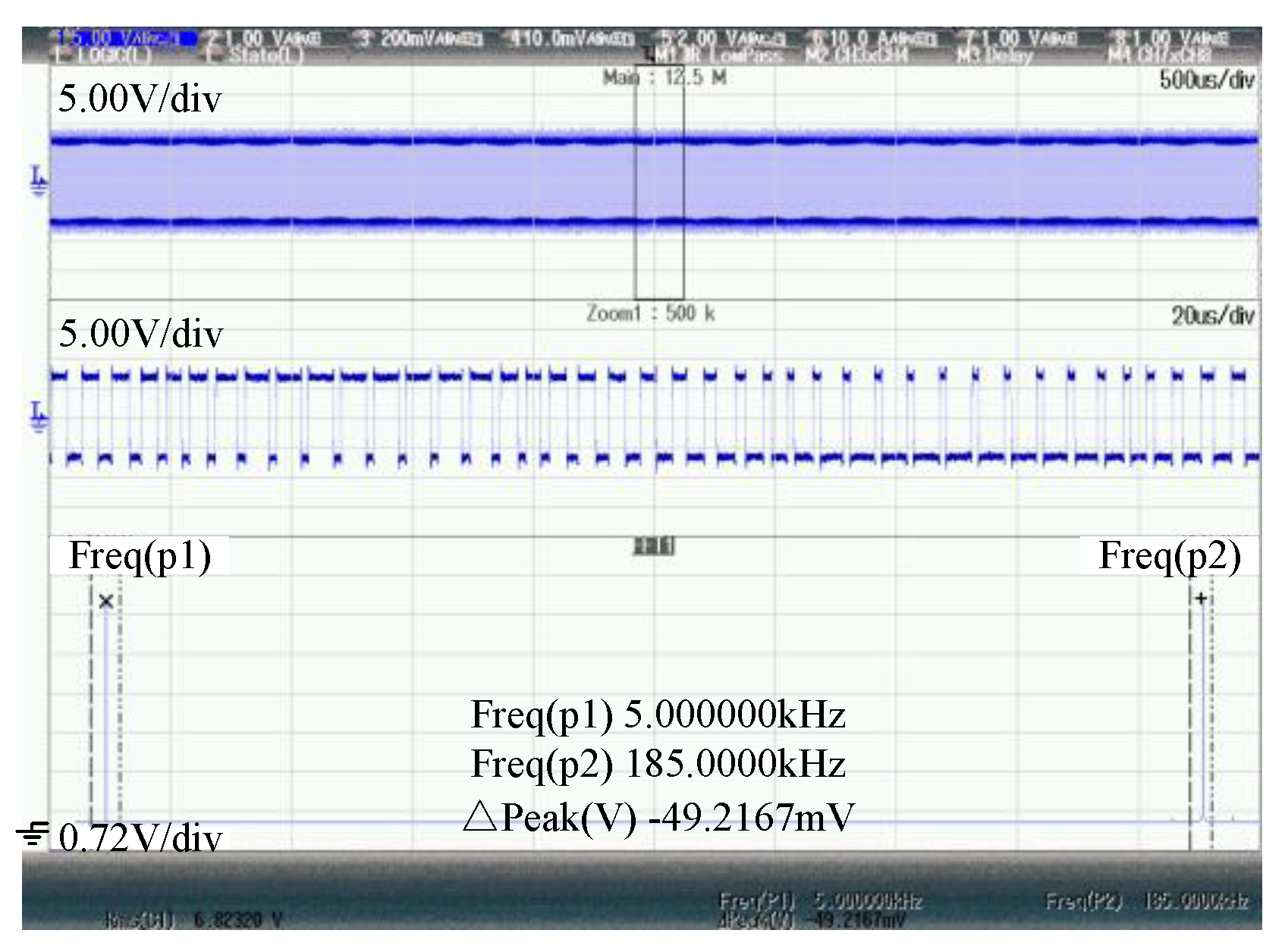
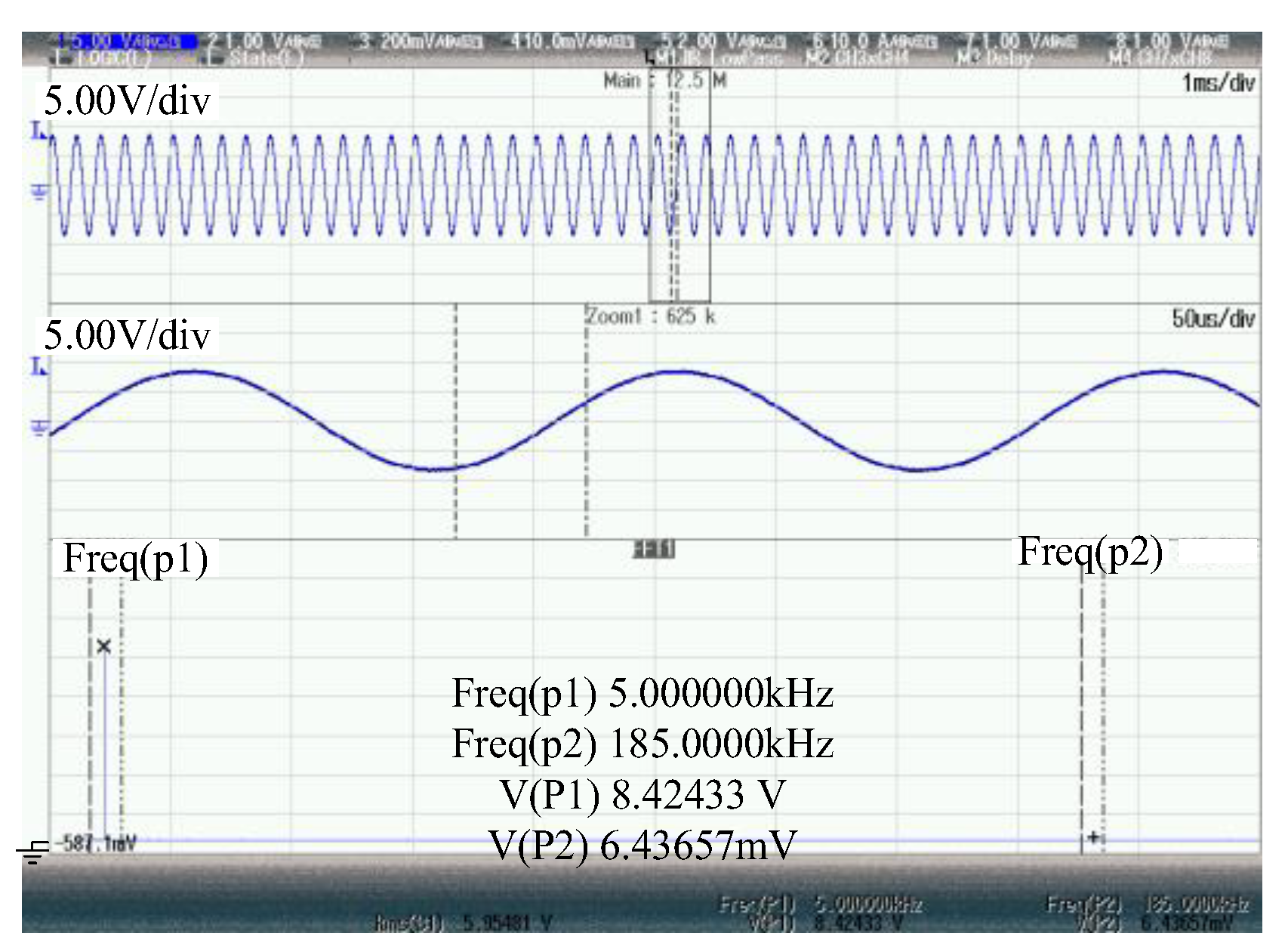
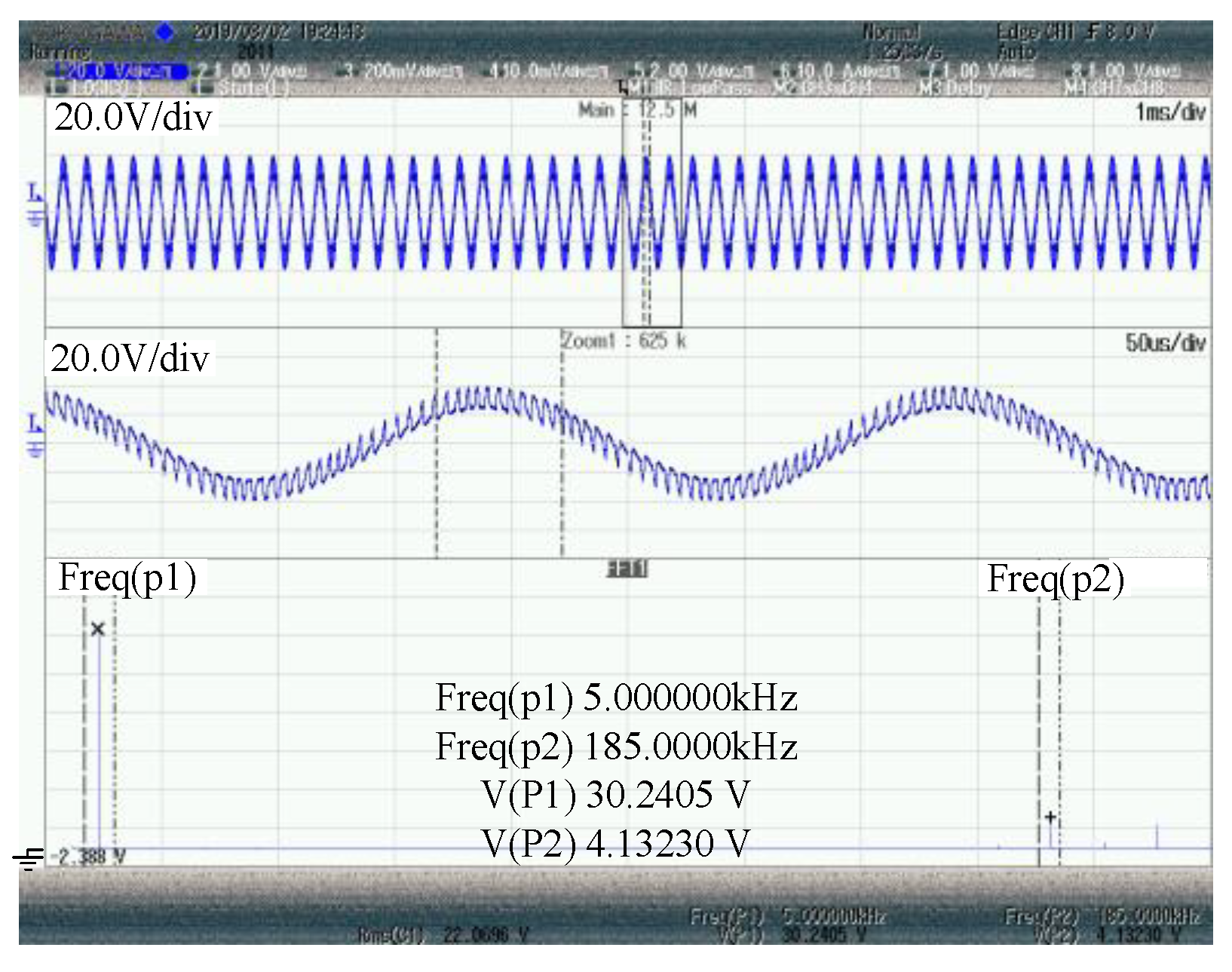
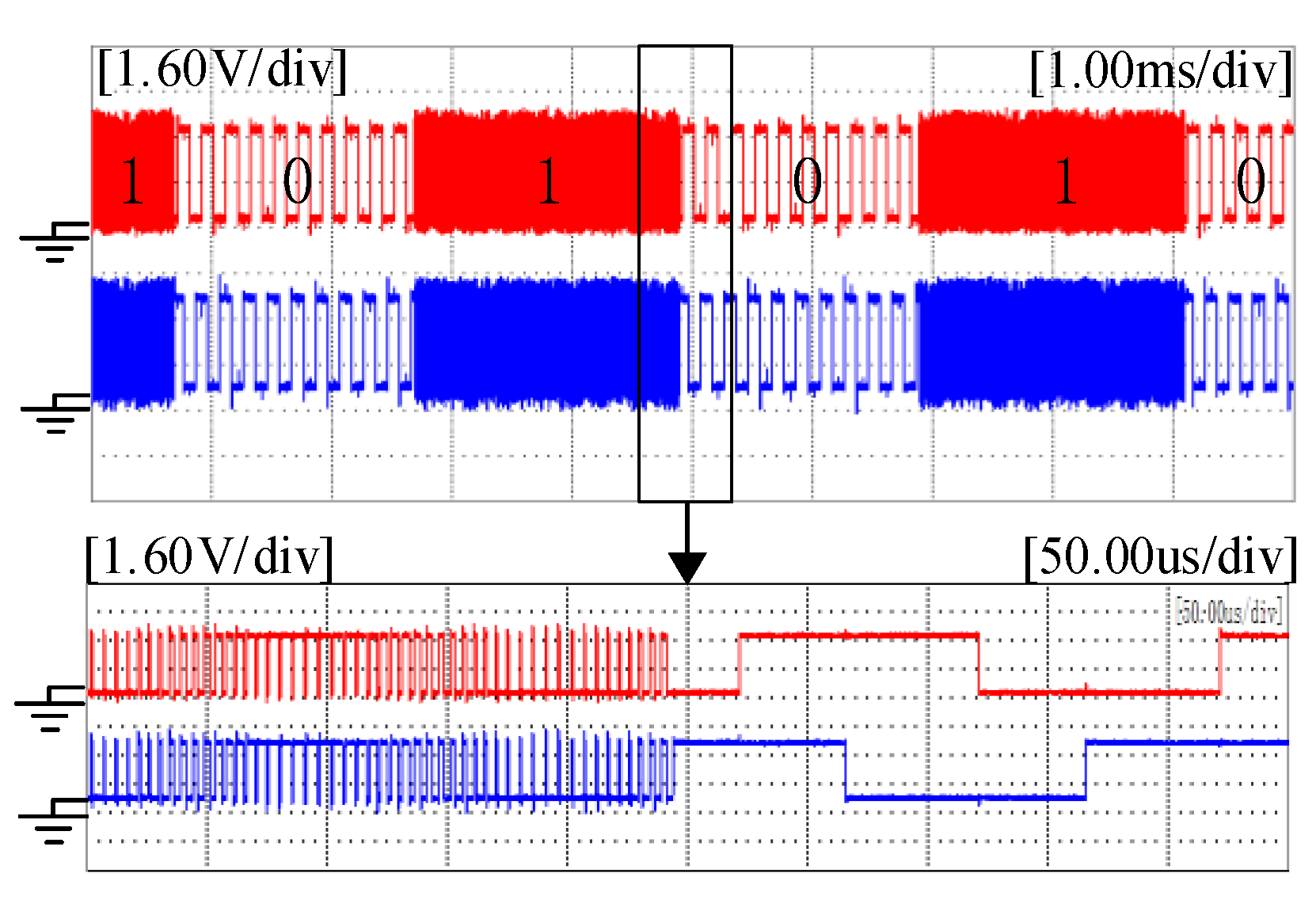
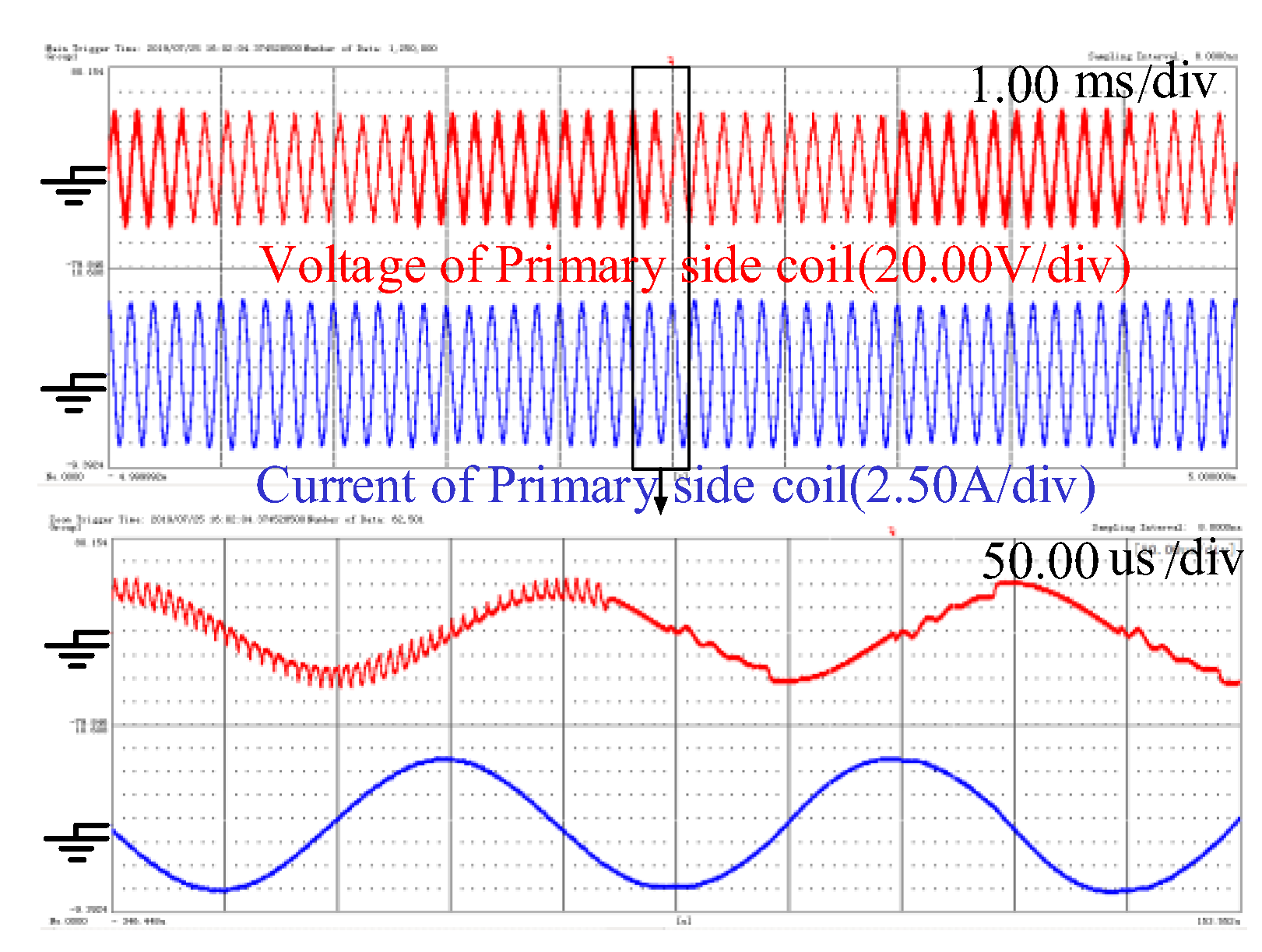
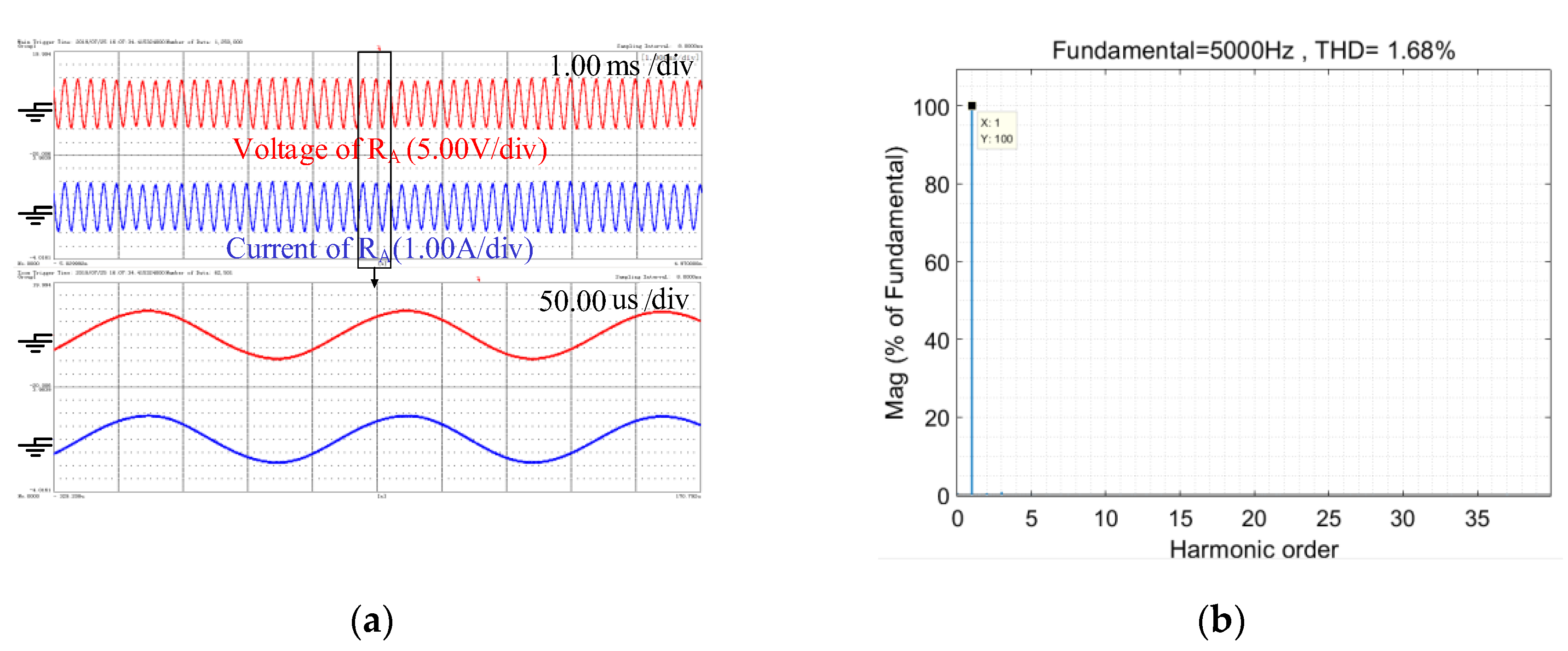
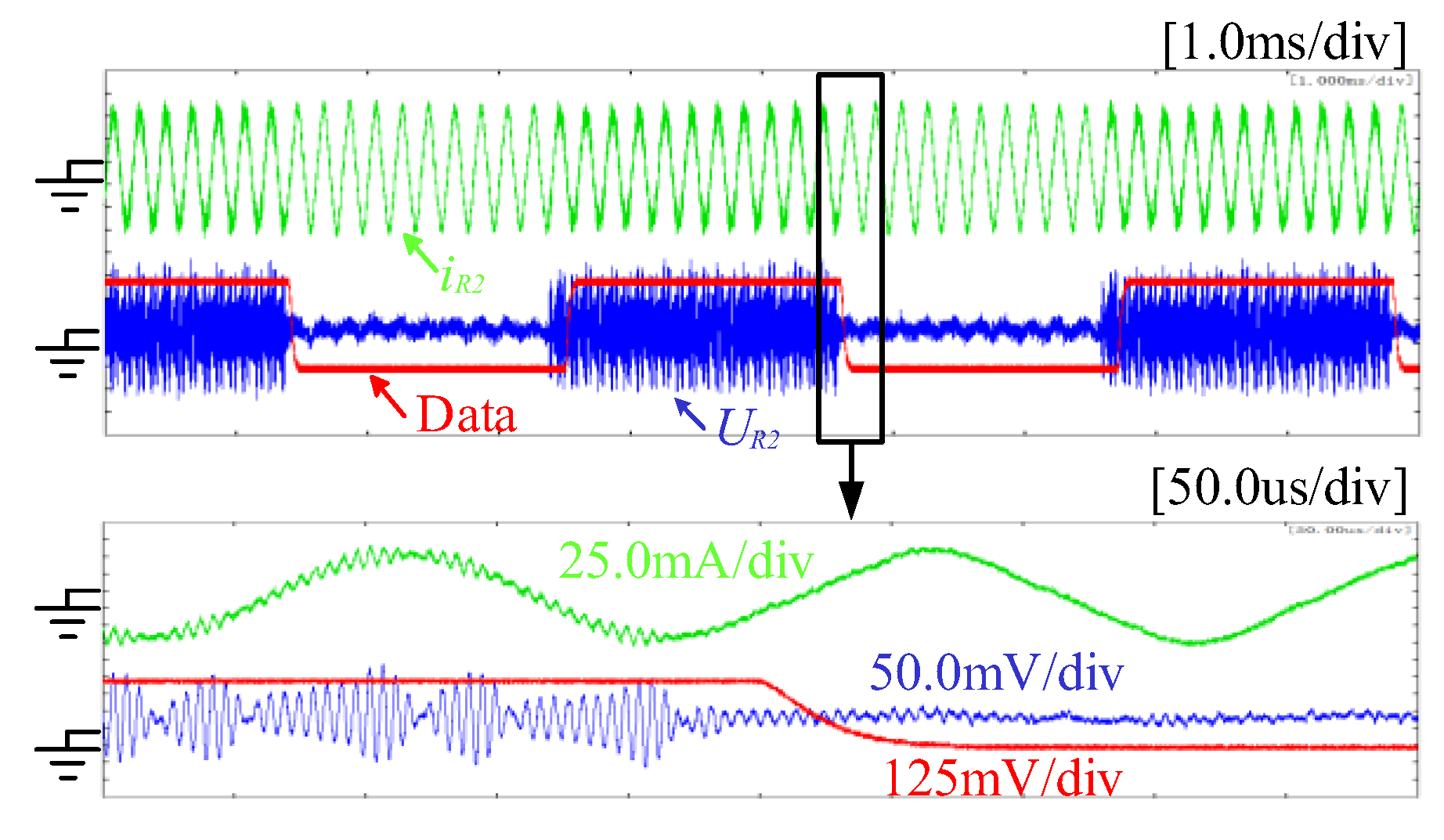
| Branch | Pass Frequency | Wave Trapper | Cut-off Frequency |
|---|---|---|---|
| () with () and () | () | ||
| () with () and () | () |
| Item | Parameter | Item | Parameter |
|---|---|---|---|
| FPGA Controller | EP4CE10 | 2.4 mH | |
| GaN Devices | GS66516T | 87 nF | |
| , | 180 uH | 11.6 mH | |
| 57.60 uH | 5 Ω | ||
| , | 5.4 uF | 60 Ω | |
| 4 nF | DC Input | 7 V | |
| , | 80 nF | Coil’s Distance | 10 cm |
| 0.448 uF | Maximum Instantaneous Power | 30 W | |
| , | 9.36 uH |
| 0.0803 | 0.1508 | 0.2398 | 0.2997 | 0.3947 |
| 0.4437 | 0.5405 | 0.5797 | 0.6786 | 0.7118 |
| 0.8219 | 0.8518 | 0.9766 | 1.0027 | 1.1394 |
| 1.1615 | 1.3069 | 1.3259 | 1.4769 | 1.4942 |
© 2020 by the authors. Licensee MDPI, Basel, Switzerland. This article is an open access article distributed under the terms and conditions of the Creative Commons Attribution (CC BY) license (http://creativecommons.org/licenses/by/4.0/).
Share and Cite
Wu, J.; Zhang, H.; Gao, P.; Dou, Z.; Jin, N.; Snášel, V. Dual-Frequency Programmed Harmonics Modulation-based Simultaneous Wireless Information and Power Transfer System via a Common Resonance Link. Sustainability 2020, 12, 4189. https://doi.org/10.3390/su12104189
Wu J, Zhang H, Gao P, Dou Z, Jin N, Snášel V. Dual-Frequency Programmed Harmonics Modulation-based Simultaneous Wireless Information and Power Transfer System via a Common Resonance Link. Sustainability. 2020; 12(10):4189. https://doi.org/10.3390/su12104189
Chicago/Turabian StyleWu, Jie, Hengyi Zhang, Pengfei Gao, Zhifeng Dou, Nan Jin, and Václav Snášel. 2020. "Dual-Frequency Programmed Harmonics Modulation-based Simultaneous Wireless Information and Power Transfer System via a Common Resonance Link" Sustainability 12, no. 10: 4189. https://doi.org/10.3390/su12104189
APA StyleWu, J., Zhang, H., Gao, P., Dou, Z., Jin, N., & Snášel, V. (2020). Dual-Frequency Programmed Harmonics Modulation-based Simultaneous Wireless Information and Power Transfer System via a Common Resonance Link. Sustainability, 12(10), 4189. https://doi.org/10.3390/su12104189






